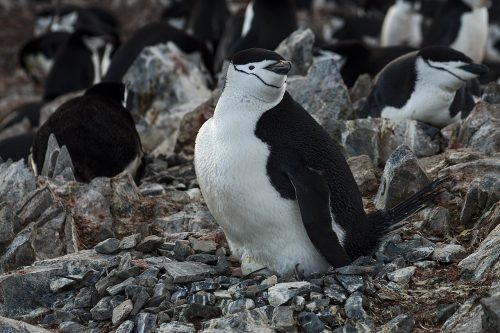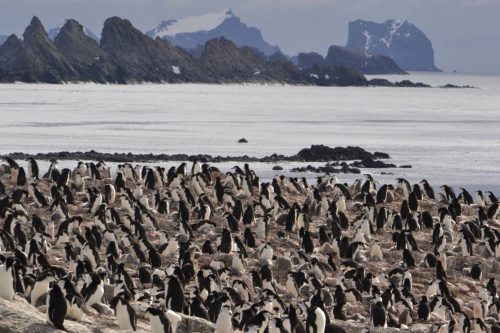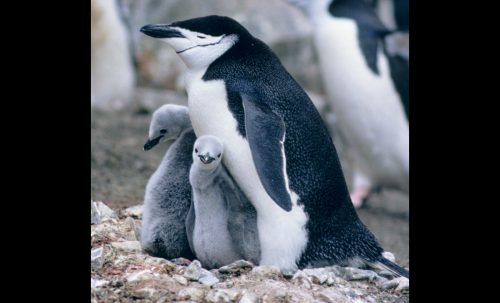King George Island, Antarctica —(Map)
Chinstrap penguins in Antarctica have adapted to harsh conditions by sleeping in a very unusual way. They sleep in short bursts – about four seconds at a time. By doing this thousands of times daily, they get about 11 hours of sleep a day.
Chinstrap penguins get their name from the thin black line under their chins, which looks like a strap holding on a black hat or helmet. Like other penguins, they spend much of their time in the water, catching fish to eat. But when the time comes to raise their young, they return to land.
Raising young penguins is a challenge. The eggs are often laid in nests made of small rocks to keep the eggs from freezing. One parent takes care of the nest for long periods of time, while the other parent hunts for food.

(Source: Rob Oo [CC BY 2.0], via Wikimedia Commons.)
The parent must constantly keep a sharp lookout. Birds called brown skuas target the eggs and young penguins of careless parents. Other penguins in these crowded areas may take stones from the nest, putting the young in danger.
But it’s hard to stay alert and protect a nest 24 hours a day. Getting a good night’s sleep could be deadly for the young. So chinstrap penguins have found an unusual way of solving the problem.
In a new study, scientists report that chinstrap penguins take thousands of tiny naps each day. Each nap – or “microsleep” – lasts only about 4 seconds. By taking over 10,000 microsleeps a day, the scientists say the penguins get a daily total of about 11 hours of sleep.

(Source: Diego Tirira [CC BY-SA 2.0], via Wikimedia Commons.)
The scientists became curious about whether the penguins were sleeping after one scientist, Won Young Lee, noticed that the chinstrap parents were constantly blinking their eyes. He wondered if more was happening than just blinking.
So he and group of scientists attached tiny electrical devices to the heads of 14 chinstrap penguins. The devices allowed the scientists to measure the brain activity of the penguins. At the same time, the scientists recorded the birds on video.
Eleven days of studying the penguins revealed that the tired parents were actually sleeping – very often, and for very short time periods.

(Source: NOAA [Public domain], via Wikimedia Commons.)
Niels Rattenborg, one of the scientists, says the penguins are always “…blinking their eyes open and shut. And they do it 24/7 for several weeks at a time.” Dr. Rattenborg says it’s surprising that they can keep going and raise their young.
It’s not clear if the microsleeps allow the penguins to actually feel rested, or if it’s just enough to allow them to keep going. But the penguins are able to keep the pattern up for weeks, which allows them to protect their nests, eggs, and babies.
The scientists don’t know yet if the penguins sleep this way at other times of the year, or only when they’re raising their young. They also don’t know if other kinds of penguins have similar sleeping habits.
Scientists who study how animals sleep say that this is an important study, and especially impressive because it was carried out in the penguins’ natural environment.
😕
This map has not been loaded because of your cookie choices. To view the content, you can accept 'Non-necessary' cookies.
